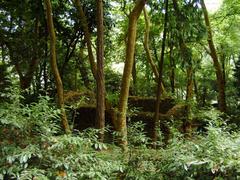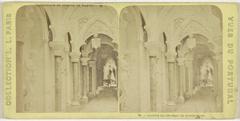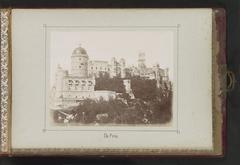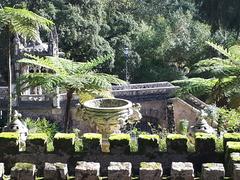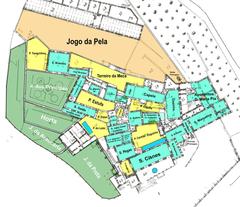Anta de Agualva Visiting Hours, Tickets, and Sintra Historical Sites Guide
Date: 03/07/2025
Introduction to Anta de Agualva and Its Historical Significance
Situated in the scenic landscape of Sintra, Portugal, the Anta de Agualva is a significant megalithic dolmen that offers visitors a rare window into the Neolithic and Chalcolithic periods, dating from approximately 4000 to 2500 BCE. This monument, with its well-preserved polygonal chamber formed by seven upright orthostats, exemplifies the funerary practices and social organization of early Iberian communities. Today, the Anta de Agualva stands as a testament to Portugal’s ancient heritage, inviting exploration and reflection on the prehistoric era of the Sintra and Lisbon region.
As a cultural landmark, Anta de Agualva is accessible to the public free of charge, typically open from 9:00 AM to 6:00 PM daily. Easily reached by public transportation from Lisbon and Sintra, the site is set within the peaceful Jardim da Anta park. Recent conservation and interpretation initiatives have improved both the structure’s stability and the visitor experience, with informative signage, guided pathways, and educational programming. Whether you are a history enthusiast, cultural traveler, or photographer inspired by ancient monuments, Anta de Agualva offers a compelling journey into Portugal’s distant past. This guide brings together authoritative research and local resources to help you plan a rewarding visit (Património Cultural; Visit Sintra; CSSC San Jurge).
Table of Contents
- Introduction
- Historical Background and Archaeological Investigations
- Visiting Anta de Agualva
- Visuals and Interactive Media
- Frequently Asked Questions (FAQ)
- Conclusion
- References and Further Reading
Historical Background and Archaeological Investigations
Prehistoric Context and Significance
Anta de Agualva is a prominent megalithic monument located in the Agualva-Cacém area of Sintra, Portugal. Dating from the Late Neolithic to the Chalcolithic (c. 4000–2500 BCE), it is part of a broader network of Iberian Peninsula funerary monuments. The dolmen reflects collective burial practices and early religious beliefs, providing key insights into the social and spiritual lives of prehistoric communities (Património Cultural).
Discovery and Early Documentation
The site was first referenced in the late 19th century by archaeologist Carlos Ribeiro amid growing interest in Portugal’s megalithic heritage. Officially recognized as a site of national interest, Anta de Agualva is recorded in the Portuguese national inventory of immovable heritage (Património Cultural).
Archaeological Investigations
Systematic excavations began in the early 20th century, revealing a polygonal chamber formed by seven orthostats. The original capstone is now missing, likely repurposed in later times. Archaeological finds include:
- Ceramic fragments with Late Neolithic decorative styles
- Lithic tools such as flint blades and arrowheads
- Ornamental beads and pendants made of bone and stone
- Fragmentary human remains indicating collective burial
Radiocarbon dating and typological studies place the primary use of the dolmen between 3500 and 2500 BCE (Património Cultural).
Conservation and Restoration Efforts
Over centuries, natural erosion and human activity posed threats to the monument. In recent decades, local heritage authorities have stabilized the dolmen’s structure, cleared invasive vegetation, and installed educational signage. Restoration in 2017 included the construction of wooden boardwalks and improved interpretive materials (CSSC San Jurge).
Comparative Context
Anta de Agualva is one of several notable megalithic sites in the Sintra and Lisbon area, including Anta de Belas and Anta do Monte Abraão. While these monuments share architectural features, each displays unique characteristics, highlighting the region’s role in prehistoric funerary traditions.
Research Developments and Public Engagement
Recent research utilizes non-invasive technologies like ground-penetrating radar and photogrammetry to study the monument. Public initiatives, including guided tours and educational programs, help integrate the site into Sintra’s broader heritage trails (Blogue Rouxinol de Pomares, 2017).
Legal Protection and Heritage Status
Declared a Monumento Nacional in 1910, Anta de Agualva benefits from legal protection, ensuring preservation and restricting unauthorized activity (Património Cultural).
Visiting Anta de Agualva
Visiting Hours and Tickets
- Hours: Open daily from 9:00 AM to 6:00 PM. Hours may vary seasonally or for conservation work; check official sources before visiting.
- Admission: Free entry; no tickets required.
Accessibility and Travel Tips
- Access: The site is a short walk from Agualva-Cacém train station, served by regular trains from Lisbon and Sintra. Local buses are also available.
- Pathways: Wooden boardwalks and marked paths improve accessibility, though some uneven ground remains.
- Facilities: Benches and shaded areas are provided in Jardim da Anta. No restrooms or cafés on-site; nearby amenities are available in Agualva-Cacém.
Nearby Attractions and Amenities
- Other Megalithic Sites: Anta de Belas and Anta do Monte Abraão.
- Cultural Landmarks: Palácio Nacional de Sintra, Moorish Castle, and Quinta da Regaleira are within easy reach.
- Local Services: Cafés and restaurants in the vicinity offer refreshments.
Guided Tours and Special Events
- Tours: Periodic guided tours are available via Sintra City Council or local tour operators.
- Events: Heritage and archaeology-related events are occasionally held; check local listings for details.
Photographic Opportunities
- Best Times: Early morning and late afternoon provide excellent light for photography.
- Tips: Capture wide shots of the monument and its natural setting. Flash photography is discouraged inside the chamber.
Visuals and Interactive Media
High-quality images, maps, and virtual tours are available on official Sintra tourism websites. For SEO and accessibility, use descriptive alt text such as “Anta de Agualva dolmen in Sintra” or “Megalithic monument in Portugal.” These resources enhance planning and on-site navigation.
Frequently Asked Questions (FAQ)
Q: What are the Anta de Agualva visiting hours?
A: Open daily from 9:00 AM to 6:00 PM. Confirm with local sources for updates.
Q: Is there an entrance fee?
A: No, admission is free.
Q: How do I get to Anta de Agualva?
A: Take a train to Agualva-Cacém station, then walk 10–15 minutes to the site. Local buses and taxis are alternatives.
Q: Is the site accessible for people with disabilities?
A: Wooden boardwalks improve access, but some uneven terrain remains.
Q: Are guided tours available?
A: Yes, but only occasionally. Inquire at Sintra’s tourism office for availability.
Q: Can I take photographs at the site?
A: Photography is allowed, but please avoid flash and respect preservation guidelines.
Conclusion
Anta de Agualva is an essential destination for anyone interested in Portugal’s ancient past. Its archaeological significance, ease of access, and tranquil park setting make it a rewarding stop within the Sintra region. Ongoing conservation and educational efforts ensure that the monument remains both protected and engaging for visitors. Enhance your visit by consulting digital resources, following site guidelines, and considering Anta de Agualva as part of a broader Sintra itinerary.
For more information, download the Audiala app for guided tours and updates, explore related articles on Sintra’s historical sites, and follow local tourism channels for the latest news.


